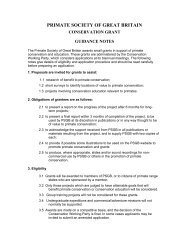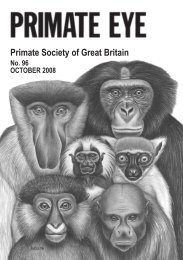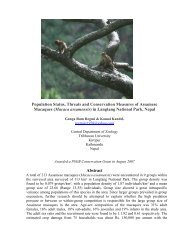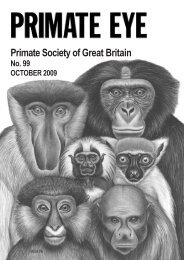2010 Vol 101.pdf (1.63mb) - Primate Society of Great Britain
2010 Vol 101.pdf (1.63mb) - Primate Society of Great Britain
2010 Vol 101.pdf (1.63mb) - Primate Society of Great Britain
You also want an ePaper? Increase the reach of your titles
YUMPU automatically turns print PDFs into web optimized ePapers that Google loves.
The case for a common gestural repertoire among great apes: evidence<br />
from the wild chimpanzees<br />
C. Hobaiter and R.W. Byrne<br />
Centre for Social Learning and Cognitive Evolution and Scottish <strong>Primate</strong><br />
Research Group, School <strong>of</strong> Psychology, University <strong>of</strong> St Andrews<br />
We compare and contrast the results from captive work on gestural<br />
communication in all great apes with observations from the first systematic<br />
study <strong>of</strong> gestural communication in wild chimpanzees, a 2-year study <strong>of</strong> the<br />
Sonso community in Budongo, Uganda. We describe the gestural repertoire<br />
<strong>of</strong> wild chimpanzees. Until recently, the acquisition <strong>of</strong> great ape gestures<br />
has been accepted to derive from ontogenetic ritualization, with<br />
communicative gestures shaped from effective actions by mutual<br />
conditioning between dyads <strong>of</strong> individuals. Biologically inherited gestures<br />
were considered to be a minor subset <strong>of</strong> gestures used inflexibly and<br />
without intention (Tomasello et al., 1985, 1994). This view has recently<br />
been challenged with data on gorilla gesture (Genty et al., 2009). Here we<br />
use evidence from wild chimpanzees, and a meta-analysis <strong>of</strong> the existing<br />
great-ape literature, to propose an alternative model <strong>of</strong> flexible, intentional<br />
gestural communication in terms <strong>of</strong> species-typical chimpanzee gestures<br />
and a family-typical repertoire <strong>of</strong> great-ape gesture.<br />
Non-linguistic vocal behaviour in human infants (Homo sapiens):<br />
primatological perspective<br />
V.Kersken, J.C.Gomez and K. Zuberbühler<br />
School <strong>of</strong> Psychology, University <strong>of</strong> St Andrews<br />
In order to examine whether infants between the ages <strong>of</strong> 7 and 20months<br />
selectively produce certain non-linguistic vocalizations in specific contexts,<br />
we observed the vocal behaviour <strong>of</strong> 30 infants in one <strong>of</strong> their natural<br />
habitats – a nursery environment. We identified the contexts in which<br />
vocalization occurred and conducted an analysis <strong>of</strong> the acoustic features <strong>of</strong><br />
the vocalizations in five distinct contexts: protests, requests for food or<br />
actions, vocalizations co-occurring with declarative pointings, and<br />
accompanying acts <strong>of</strong> giving objects to others. A discriminant function<br />
analysis was conducted on different acoustic variables <strong>of</strong> each <strong>of</strong> the 209<br />
calls and could correctly classify 56.8% <strong>of</strong> the call types. We conducted a<br />
Monte Carlo simulation and found that the model could classify<br />
significantly more cases correctly than a randomly generated data set (chi<br />
squared = 26.99, df = 1, p> .0001). The results suggest that prelinguistic<br />
infants do produce vocal behaviours selectively in certain contexts and that<br />
these classes <strong>of</strong> vocalizations might serve specific functions be. Although<br />
this is not a complete description <strong>of</strong> infant vocal behaviour, it nevertheless<br />
suggests some homogenous classes <strong>of</strong> non-linguistic vocalizations that are<br />
systematically related to their production context and therefore could<br />
9






